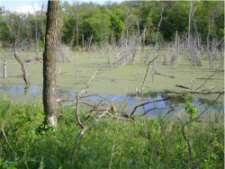



Be On The Lookout For Blue-Green Algae
By Roxanne Johnson, NDSU Agriculture Communication. Producers need to watch for the development of blue-green algae on livestock water supplies.The North Dakota State University Extension Service’s water quality associate is urging producers to watch for green to blue-green scum or a gelatinous mass on the surface of their livestock’s fresh water supplies.
“Algae blooms cause major disruptions not only because of their offensive odor and appearance; they can be potentially fatal to livestock,” Roxanne Johnson says. “Not all algae blooms are toxic, but without laboratory analysis, it is impossible to identify poisonous species.”
 |
| Blue-green algae is spreading in this pond in the Sully's Hill National Game Preserve near Devils Lake. |
This seasonal event is not really an algae, but photosynthetic bacteria called cyanobacteria that rely on sunlight for energy. As they store energy, they create a tiny cavity of air that allows them to move up and down in the water to areas with more nutrients. As environmental conditions improve with warm weather, calm winds and abundant nutrients (particularly phosphorus and nitrogen), the bacteria numbers increase. A “bloom” of green or blue-green algae on the surface of the water may appear overnight, accompanied by an unmistakable musty, earthy or putrid odor.
“As cyanobacteria break down, they release toxins that can be an irritant to human skin and potentially lethal to animals,” Johnson explains.
Concentrations of algae develop as winds move the toxin to the leeward, or downward, shore, where producers may find evidence of toxicity, such as dead mice, snakes and other animals near the water’s edge. Toxicity is dependent on the species consuming the water, and the concentration and the amount of water ingested.
Blue-green algae produce two toxins, each with different symptoms. Signs of neurotoxin poisoning usually appear within 15 to 20 minutes of ingestion. In animals, symptoms include weakness, staggering, difficulty in breathing, convulsions and ultimately death. In humans, symptoms may include numbness of the lips, tingling in fingers and toes, and dizziness. Signs of liver poisoning may take hours or days to appear. Liver toxins can cause abdominal pain, diarrhea and vomiting in humans and death in animals.
Most blooms are obvious to the naked eye; however, blue-green algae can be in water without a visible bloom, Johnson says. She advises producers to treat their water if they’ve previously had blooms.
Treatments include using an aeration/mixing device to create turbulence in the water and minimizing nutrient levels in the water by establishing vegetated buffer strips around the water to intercept and trap nutrients and sediments. Another long-term strategy is limiting livestock’s access to ponds or dugouts to areas that have been stabilized to prevent damage from trampling. Producers also may choose to pump water to a tank or trough after fencing the water source to keep livestock out.
Johnson advises producers to clean stock tanks on an annual basis to keep algae growth to a minimum.
Some producers are adding dyes, such as Aquashade, Blue Lagoon and Admiral, to nonflowing pond water to filter out ultraviolet rays. According to the products' labels, this treatment is most effective when used early in the season for water intended for livestock consumption. It is not recommended for human drinking water.
Algaecides, such as copper sulfate, are effective in killing algae blooms. However, these algaecides also can kill fish and damage the ecosystem of inland waters, Johnson says. Lethal levels of toxins may result as a consequence of algae cell walls rupturing when copper sulfate is used.
For procedures on treating water, check NDSU Extension Service publication AS-954, “Livestock and Water.”
Other treatments include suspending barley straw, loosely in a mesh bag, in the affected pond. A study from the Center for Aquatic Plant Management in Berkshire, England, says the most effective time to apply straw is before algae growth begins because the anti-algae agents released by the straw are more effective in preventing algae growth than in killing algae. The straw becomes active within a month and will continue to inhibit algae growth up to six months.
“While there are no quick fixes to control blue-green algae once they appear, reducing the amount of nutrients washed into ponds may eventually lessen the intensity of the bloom,” Johnson says.


